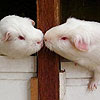
The dish is prized for the thin, crispy skin, with authentic versions of the dish serving mostly the skin and little meat, sliced in front of the diners by the cook. Ducks are bred specially for the dish, which after 65 days are slaughtered and seasoned before being roasted in a closed oven or a hung oven. The meat is often eaten with pancakes, spring onions, and hoisin sauce or sweet noodle sauce. A variant of the dish known as crispy aromatic duck has been created by the Chinese community in the United Kingdom. The two most notable restaurants in Beijing which serve this delicacy are Quanjude and Bianyifang, two centuries-old establishments which have become household names.
By the Qianlong Period (1736-1796) of the QianDynasty, the popularity of the Peking Duck spread to the upper classes, inspiring poetry from poets and scholars who enjoyed the dish. For instance, one of the verses of Duan Zhu Zhi Ci, a collection of Beijing poems was, "Fill your plates with roast duck and suckling pig". In 1864, the Quanjude (全聚德) restaurant was established in Beijing. Yang Quanren (楊全仁), the founder of Quanjude, developed the hung oven to roast ducks. With its innovations and efficient management, the restaurant became well known in China, introducing the Peking Duck to the rest of the world.
By the mid 20th century, the Peking Duck had become a national symbel of China, favoured by tourists and diplomats alike. For example, Henry Kissinger, the Secretary of State of the United States met Premier Zhou Enlai in the Great Hall of the People on July 10, during his first visit to China. After a round of inconclusive talks in the morning, the delegation was served Peking Duck for lunch, which became Kissinger's favourite. The Americans and Chinese issued a joint statement the following day, inviting President Richard Nixon to visit China in 1972. The Peking Duck was hence considered one of the factors behind the rapproachement of the United States to China in the 1970s. Following Zhou's death in 1976, Kissinger paid another visit to Beijing to savour Peking Duck. The Peking Duck, at the Quanjude in particular, has also been a favorite dish for various political leaders ranging from Cuban revolutionary Fidel Castro to former German chancellor Helmut Kohl.[10][11]


The hung oven was developed in the imperial kitchens during the Qing Dynasty and adopted by the Quanjude restaurant chain. It is designed to roast up to 20 ducks at the same time with an open fire fuelled by hardwood from peach or pear trees. The ducks are hung on hooks above the fire and roasted at a temperature of 270 °C (525 °F) for 30–40 minutes. While the ducks are cooking, the chef may use a pole to dangle each duck closer to the fire for 30 second intervals.
Besides the traditional methods to prepare Peking duck, recipes have been compiled by chefs around the world to produce the dish at home.



